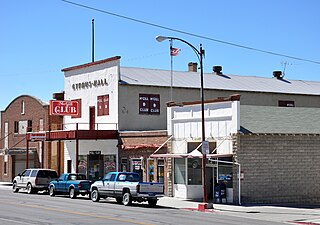
McGill is a census-designated place (CDP) in White Pine County, Nevada, United States. The population was 1,148 at the 2010 census.

Eureka is a city in Juab County, Utah, United States. It is part of the Provo–Orem metropolitan area. The population was 669 at the 2010 census, down from 766 in 2000.

Goldfield is an unincorporated town and census-designated place and the county seat of Esmeralda County, Nevada.

Eureka is an unincorporated town and census-designated place in and the county seat of Eureka County, Nevada, United States. With a population of 414 as of the 2020 United States census, it is the second-largest community in Eureka County. Attractions include the Eureka Opera House, Raine’s Market and Wildlife Museum, the Jackson House Hotel, and the Eureka Sentinel Museum.

Austin is an unincorporated small town in, and former county seat of, Lander County, Nevada, United States. In 2020, the census-designated place of Austin had a population of 167. It is located on the western slopes of the Toiyabe Range at an elevation of 6,575 feet (2,004 m). U.S. Route 50 passes through the town.
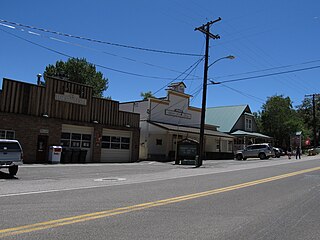
Genoa is an unincorporated town in Douglas County, Nevada, United States. Founded in 1851, it was the first settlement in what became the Nevada Territory. It is situated within Carson River Valley and is approximately 42 miles (68 km) south of Reno. The population was 939 at the 2010 census. It is home to the oldest bar in the state of Nevada which opened in 1853.

The Nevada Northern Railway was a railroad in the U.S. state of Nevada, built primarily to reach a major copper producing area in White Pine County, Nevada. The railway, constructed in 1905–06, extended northward about 140 miles (230 km) from Ely to connections with the Western Pacific Railroad at Shafter and Southern Pacific Railroad at Cobre. In 1967 NN reported 40 million net ton-miles of revenue freight on 162 miles (261 km) of line.

Belmont is a ghost town in Nye County, Nevada, United States along former State Route 82. The town is a historic district listed in the National Register of Historic Places. It is Nevada Historical Marker number 138.

Aurora is a ghost town in Mineral County in the west central part of the US state of Nevada, approximately 22 mi (35 km) southwest of the town of Hawthorne, three miles from the California border.
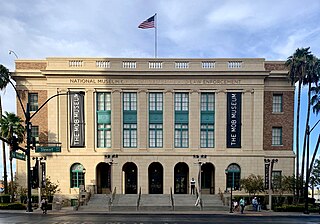
Las Vegas Post Office and Courthouse is a Neo-classical building located in Downtown Las Vegas, Nevada. It is listed on the United States National Register of Historic Places.
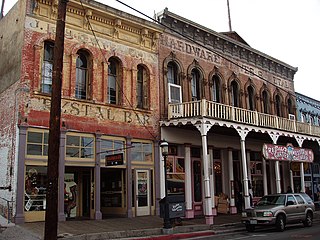
Virginia City Historic District is a National Historic Landmark District encompassing the former mining villages of Virginia City and Gold Hill, both in Storey County, as well as Dayton and Silver City, both to the south in adjacent Lyon County, Nevada, United States. Declared a National Historic Landmark in 1961, the district is one of only six in the state of Nevada.
Silver mining in Nevada, a state of the United States, began in 1858 with the discovery of the Comstock Lode, the first major silver-mining district in the United States. Nevada calls itself the "Silver State." Nevada is the nation's second-largest producer of silver, after Alaska. In 2014 Nevada produced 10.93 million troy ounces of silver, of which 6.74 million ounces were as a byproduct of the mining of gold. The largest byproducers were the Hycroft Mine, the Phoenix Mine, the Midas Mine and Round Mountain.

The 1938 Lincoln County Courthouse is an Art Moderne style building in Pioche, Nevada. The 1938 courthouse replaced the so-called "million-dollar courthouse" built in 1871, whose last payment on the approximately $800,000 it cost was coincidentally made in 1938.

The first Lincoln County Courthouse, also known as the Pioche Courthouse and the Old Lincoln County Courthouse, in Pioche, Nevada earned the title "Million Dollar Courthouse" after it cost $75,000 to build in 1872, for a relatively small building. With added costs attributed to finance charges and fiscal mismanagement, the cost in 1872 dollars came to over $800,000. The debt incurred by the county was not retired until 1938, when the new courthouse was under construction.

Bristol Wells, also known as National City, Bristol City and Tempest, is a ghost town in Lincoln County, Nevada. The mining town was located on the west side of Bristol Mountain, 14 miles (23 km) northwest of Pioche, Nevada.

The Fourth Ward School is an historic 4-story mansard-roofed former public school building located at 537 South "C" Street in Virginia City, Nevada. Designed in 1876 by architect C. M. Bennett in the Second Empire style of architecture, it originally held over 1000 students in grades 1 though 9 divided into three departments: primary (grades 1 though 4); second grammar and high school. Grades 10 through 12 were added by 1909. It graduated its last class in 1936, after which its students were moved to a new school built by the Works Progress Administration.

Ruby Hill is a ghost town in Eureka County, in the central part of the U.S. state of Nevada, approximately 2.6 mi (4.2 km) west of the town of Eureka, Nevada. In 1910, the Ruby Hill Railroad was washed out, after which there were only three businesses in town.

The Stone Jail Building and Row House are two adjacent stone buildings located on Water Street in Tonopah, Nevada. The jail was built in 1903 and the adjacent row house in 1908. Both building were at one time used as a brothel. The buildings were added to the National Register of Historic Places in 1982.
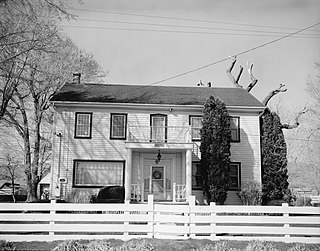
The Peleg Brown Ranch, at 12945 Old Virginia Rd. in Reno, Nevada, dates from 1864. Also known as the Louis Damonte Ranch, it includes Bungalow/craftsman and Greek Revival architecture. It was listed on the National Register of Historic Places in 1994; the listing included five contributing buildings on about 4 acres (1.6 ha).
The Silver City Cemetery, is a historic cemetery in the ghost town of Silver City, Utah, United States, that dates from the 1870s and is listed on the National Register of Historic Places (NRHP).




















